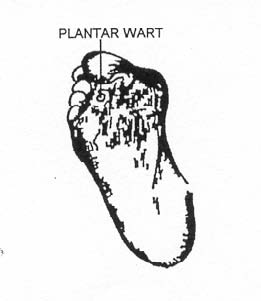The Musculoskeletal System
Lesson 2: Diseases and Disorders of the Feet
Section IV: Arthritis of the Feet
2-22
2-22. VERRUCAE (PLANTAR WARTS)
These lesions are common benign skin tumors caused by a virus the body has not been able to fight off. These bumps are spongy, sometimes thickened, and scaly lesions. Warts can appear anywhere on the skin. They can be particularly painful if they occur on the soles of the feet because the soles of the feet bear the weight of the body. The scientific name for a wart is verruca. When the wart occurs on the bottom of the foot (figure 2-12), the wart is called plantar verruca. This term simply gives the location of the wart, plantar meaning having to do with the sole of the foot.
a. Types of Plantar Warts. Even on the feet, all warts are not the same.
(1) One type of plantar wart is the single isolated wart. This wart can range from a tiny dot to a bigger, callused, blotch two to three centimeters in diameter.
(2) The second type of plantar wart is the mother-daughter group. The first and larger wart is called the "mother," and the warts which appear around this original wart are sometimes referred to as "daughters."
(3) The third and last type of plantar wart is the mosaic plantar wart. This is a cluster of many warts grouped together often appearing over the balls of the feet.
Figure 2-12. Plantar wart.
b. Signs/Symptoms of Plantar Warts. Included are the following:
(1) Tenderness.
(2) Pain.
(3) Pinpoint bleeding.
(4) Central core.
(5) Flattened tumors surrounded by cornfield epithelium.
NOTE: Plantar warts are the same as warts on the hands, the only difference being the location of the wart on the feet.
c. Treatment of Plantar Warts. There are many ways to treat warts, from covering the wart with a clove of garlic to laser treatment. Here is the AMEDD procedure to be followed:
(1) Freeze the wart with liquid nitrogen.
(2) Pare wart until bleeding or pain occurs.
(3) Apply a solution of 40 percent salicylic acid plaster and keep this in place for one week.
(4) Remove debris.
(5) Repeat paring, applying solution, debriding until the plantar warts are gone.
(6) Use foam pads in boots to relieve pressure and prevent recurrence.


